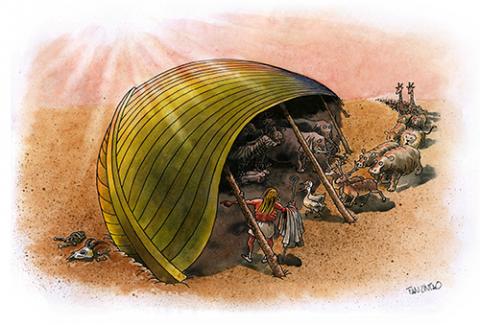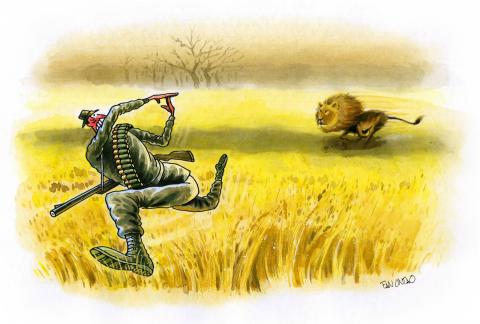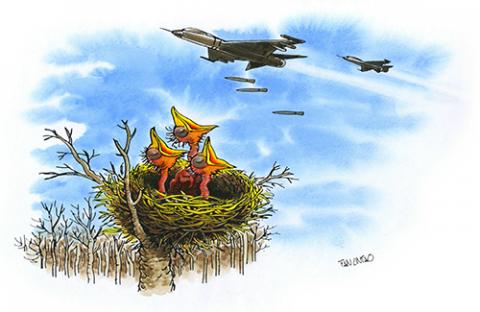Puede sonar a frase hecha, falsa, pero tengo que escribirla ahora de todas maneras: es un honor real, un placer, tener en este “vis a vis” de hoy al humorista gráfico chino Fan Lintao.
Sabemos que gana premios por montones cada año en concursos internacionales de caricaturas. Sabemos que es muy requerido para ser jurado en muchísimos concursos por todo el orbe. Sabemos que ha expuesto en innumerables países. Sabemos que colabora con sus obras en variadas publicaciones de su país y en el mundo.
Por todo lo anterior, es un privilegio entrevistarlo.
Pero la mayor razón es que me encantan sus obras. Le recomiendo a nuestros lectores navegar por el ciberespacio buscándolas, para que comprueben su Maestría.
Los que me conocen están esperando un sencillo juego de palabras desde que lo presenté, y ahí va: sí, soy extremadamente fan de Fan.
Pero basta de presentación y comencemos este “vis a vis con la vis cómica” de Fan Lintao.
PP: Estimado amigo, ¿te gusta que te entrevisten?
FAN: Sí, me alegro de que me entrevistes, para que más lectores de "Humor Sapiens" puedan conocerme.
PP: Me alegro mucho, porque sé que tenemos muchos lectores que quieres conocer más. Bueno, para ese público de Humor Sapiens, ¿pueden presentarse? (Porque quizás mi presentación quedó incompleta). ¿Cómo te gustaría ser conocido, recordado?
FAN: Me encantaba el graffiti desde la escuela primaria. A menudo escribía mis propias historias y dibujaba pequeñas caricaturas como cómics. Después de ver estas pinturas, los compañeros y vecinos dieron comentarios positivos y aliento.
Cuando estaba en quinto grado, mi libro ilustrado participó en tareas de estudiantes, ensayos y exhibiciones de artesanías de la escuela. Es el único libro de pintura expuesto y causó cierta sensación. A partir de entonces, todos los profesores y alumnos de la escuela supieron que yo era el alumno de primaria que dibujaba bien.
Mi obsesión por la pintura es lo que me impulsa a persistir en el dibujo. Desde la secundaria me ha apasionado dibujar y dibujar. Ni siquiera salgo del aula durante los descansos, estoy dibujando. A veces dibujo en mis sueños y me despierto con las manos moviéndose.
Aunque siempre me han gustado las caricaturas, en realidad comencé a crearlos en 1980. Estas obras de dibujos animados se exhibieron en exposiciones de arte locales y fueron amadas y elogiadas por muchos espectadores. En 1982, mi trabajo debut "Peso neto" se publicó en el Zibo Daily. Se han publicado más de 6.000 dibujos míos en periódicos y revistas nacionales y extranjeros.
PP: Eres muy afortunado al descubrir de bien niño tu vocación. ¡Y por suerte para nosotros seguiste en carrera! Amigo, ¿a estas alturas de la vida te ríes de más cosas que antes? Si es así, ¿es porque eres más sabio, tienes menos prejuicios, has aprendido lecciones, te importan menos las consecuencias o todo lo anterior?
FAN: Tienes razón, me río más que antes. Esto se debe a que mis trabajos de humor gráfico son más maduros y se han ganado el amor de más lectores y el reconocimiento de mis colegas. También he ganado más premios en concursos internacionales. He sido muchas veces jurado en concursos internacionales, lo que me ha dado la oportunidad de conocer a más colegas extranjeros. Mis exposiciones personales se han realizado con éxito, tanto a nivel nacional como internacional.
PP: Sin dudas, la seguridad y el reconocimiento provoca que se abra la mente y los intereses y aumente las fuentes de nuestras risas. Dime ahora, ¿empezaste a dibujar sin estilo? Si tuvieras uno, ¿qué estilo sería? ¿Tuviste alguna influencia de caricaturistas nacionales o extranjeros en ese momento? ¿Cómo ha evolucionado tu trabajo a lo largo del tiempo en términos de forma y contenido? (No me refiero a que cada vez tengas más calidad, sino a los cambios en tu predilección en forma y contenido.
FAN: Creo que el estilo de una obra se forma gradualmente a medida que mejora el nivel de apreciación, explora más obras nacionales y extranjeras excelentes y acumula experiencia de más obras, y no hay forma de "reservar" con anticipación. Tenía muchos dibujantes nacionales y extranjeros favoritos en las primeras etapas de la creación de caricaturas y aprendí mucho de ellos. Pero no me gusta imitar el estilo de otra persona, al fin y al cabo, eso es lo que tienen. Los caricaturistas deben tener su propio estilo, y los lectores pueden saber quién lo pintó simplemente mirando la pintura, sin mirar el nombre del autor.
Mi creación dentro del dibujo humorístico se puede dividir en tres etapas.
Fase 1: Las obras anteriores a 1997 fueron dibujadas a mano con líneas blancas y negras.
Fase 2: Las obras de 1997 a 2004 fueron dibujadas a mano con líneas y luego coloreadas por computadora.
La tercera etapa: Después de 2004, se utilizaron líneas dibujadas a mano y luego se utilizaron acuarelas para colorear.
Cuando me cansé del "sabor a máquina" del procesamiento de imágenes por computadora, comencé a volver a la simplicidad y a disfrutar del encanto natural del dibujo a mano. Me gusta la perfecta integración del agua y el color en las acuarelas, creando manchas y marcas de color en papel de acuarela. Estos efectos de textura especiales tienen una fuerte aleatoriedad y lirismo. Esto encaja perfectamente con los dibujos que no están limitados por reglas y regulaciones, lo que realza el poder expresivo de las obras de las caricaturas.
PP: Bueno, acabas de dar una clase magistral. Estoy de acuerdo en todo contigo. Uno lo prueba todo y se queda con lo que más le gusta, aunque tenga que regresar a técnica anteriores. Muy bien, Fan. Seguimos entonces. ¿Qué forma prefieres: dibujar con humor sin palabras o dibujar con textos? ¿Por qué?
FAN: Me gustan el humor gráfico sin palabras, que también son reconocidos como los trabajos de más alto nivel en la industria. Porque las caricaturas se basan en imágenes para "hablar" en lugar de palabras. Si la imagen no puede expresar plenamente la intención del autor, es necesario añadir texto. Y personas de todo el mundo pueden entender los dibujos animados sin texto. Todas mis obras no tienen palabras. A menudo bromeo diciendo que mi trabajo es un producto de "tres no": sin texto, sin título, sin fronteras.
PP: De nuevo estamos de acuerdo. Por supuesto, he disfrutado de excelentes obras de humor gráfico con texto, pero me llegan más las que no lo tiene. Ahora cuéntame, entre los muchos premios que has recibido, ¿cuál te conmovió más o te impactó más?
FAN: Creo que es el trabajo con el que gané el primer premio en la 9ª Exposición Internacional de Caricaturas - Yimittos, Grecia. Este es un trabajo del que estoy muy satisfecho.
PP: Eres el primer entrevistado en esta sección “vis a vis” que me responde esa pregunta confesando que fue por una obra en específico. Siempre se trata del significado por ser el primer premio recibido, o el más importante, o por el momento de su vida que lo recibió, etc. Cambio ahora por algo más teórico. ¿En tu opinión qué es el humor? ¿Qué es el humor gráfico?
FAN: Creo que el humor es algo escrito en el ADN de una persona. Será estimulado en diferentes ocasiones, haciendo que la gente se sienta feliz y ría. Todo el mundo tiene sentido del humor, pero en distintos grados. Los dibujos humorísticos están diseñados para hacer que los lectores resuenen con sus genes humorísticos después de leerlos, logrando así un estado de ánimo feliz, alegre y que induzca a la risa.
PP: Sobre ese punto… Cuéntame qué humor te gusta más hacer. Te doy variantes:
a-El que simplemente te divierte.
b-El que te divierte y te hace pensar.
c-El que te hace pensar, pero sólo es crítico, satírico.
d-El burlesco, irrespetuoso, ofensivo.
FAN: Elijo a y b.
PP: ¡Perfecto! Los mismos que elegiría yo. Estamos en frecuencia. Y ahora una pregunta de moda: ¿cuáles son para ti los límites del humor, si los hubiera?
FAN: Creo que mientras no viole ni ofenda la ética, la moral, la civilización, las costumbres populares, la religión, el consenso social y no haga que la gente se sienta aterrada, repugnante, incómoda, vulgar, etc., el humor no debe limitarse.
PP: Coincido mucho contigo, Fan. En cada pregunta me hago más “fan” tuyo. Y para continuar con el tema anterior, ¿alguna vez te han censurado? ¿Te autocensuras mucho, poco o nunca?
FAN: Mis obras son todas humorísticas y no han sido revisados ni necesitan ser revisados. Reviso sí cada pieza de mi trabajo. Esto incluye borradores conceptuales y trabajos terminados. Esto es útil para mejorar la calidad de futuros trabajos.
PP: Como debe ser. Pero hay colegas que son censurados en sus países y desarrollan la capacidad de autocensurarse para sobrevivir. Me alegro que no sea tu caso. Y, ¿Cómo ves el presente y el futuro del humor gráfico?
FAN: Creo que las caricaturas nunca desaparecerán, es solo que los medios que las muestran cambian constantemente. Por ejemplo, desde los primeros medios impresos hasta diversas formas de medios en línea en la actualidad. Y ahora se difunde más ampliamente, más rápido y también es fácil de guardar y recuperar. Definitivamente, existirán mejores formas de difundir dibujos humorísticos en el futuro.
PP: Como te noto bien optimista -si me permites-, vamos a darle un tono más alegre a este vis-à-vis: ¿podrías contarnos alguna anécdota cómica, curiosa o ingeniosa que hayas vivido durante tu carrera en el humor?
FAN: Una vez, en una reunión nocturna con amigos, beber alcohol era fundamental. Incapaz de soportar el alcohol, regresé a casa y me estaba preparando para descansar cuando de repente recibí una solicitud del periódico para una ilustración. La escena es un zorro cazando una gallina. Dibujé las ilustraciones aturdido y las envié al periódico. Al día siguiente, cuando me desperté, de repente recordé que la ilustración que dibujé anoche no incluía una cola de zorro. Me doy prisa y enciendo la computadora para comprobar esa imagen. Efectivamente, olvidé dibujar la cola del zorro. Afortunadamente, los lectores pueden entenderlo como el pollo bloqueando la cola del zorro.
PP: Ja, ja. Salió bien igual. Bueno, para ir cerrando ¿quieres que te haga una pregunta que no te hice? Si es así, ¿podrías responderla ahora?
FAN: Bien, sería sobre la importancia de las habilidades de dibujo para los autores de humor gráfico. Los dibujos transmiten las ideas del autor a través de la pintura. Entonces, para expresar mejor lo que imaginas en tu cerebro, debes tener sólidas habilidades para pintar. Aunque las caricaturas pueden distorsionarse y exagerarse, en ellos están implícitas buenas técnicas de pintura, de modo que las obras pueden dar a las personas una sensación de belleza. Deshazte de la creencia de algunas personas de que las caricaturas son sólo garabatos y que son pinturas rotas. La estructura del cuerpo humano, la combinación de colores, el dibujo en perspectiva, la composición, etc., son habilidades básicas de pintura esenciales. Dominar estas habilidades traerá beneficios para toda la vida.
PP: Perfecto, amigo mío. Ese conocimiento les hace falta a unas cuantas personas. Gracias. Y ahora, por último, ¿podrías decirles unas palabras a nuestros lectores de Humor Sapiens?
FAN: Espero que los lectores de "Humor Sapiens" puedan leer más pinturas humorísticas, ser felices, saludables y vivir una vida larga. También espero que los lectores de Humor Sapiens disfruten de mis trabajos de dibujos humorísticos.
PP: No te quepa la menor duda, amigo mío. Tu calidad de humorista gráfico te convertirá muy pronto en uno de los favoritos de este sitio, porque ya lo eres en casi todo el mundo…
Espero que te hayas divertido en este vis a vis. Fue un gran placer y un honor para mí, por eso una vez más mi agradecimiento y te deseo mucha salud y éxito continuo, porque te queda mucho para dar.
FAN: Muchas gracias por esta entrevista, Pepe. Acepte buenos saludos desde China. También espero que lo que dije pueda satisfacerte. Espero tener la oportunidad de volver a encontrarme con lectores de "Humor Sapiens" a través de usted.
(Este texto fue traducido al Español por Google Translate)





Interview with Fan Lintao
By Pepe Pelayo
t may sound like a cliché, false, but I have to write it now anyway: it is a real honor, a pleasure, to have the Chinese cartoonist Fan Lintao in today's "visa a vis".
We know that he wins tons of awards every year in international cartoon competitions. We know that it is very required to be a jury in many competitions around the world. We know that he has exhibited in countless countries. We know that he collaborates with his works in various publications in his country and around the world.
For all of the above, it is a privilege to interview him.
But the biggest reason is that I love his works. I recommend that our readers navigate cyberspace looking for them, so that they can verify their Mastery.
Those who know me have been waiting for a simple pun ever since I introduced it, and here it goes: "yes, I'm an extremely fan of Fan."
But enough of the introduction and let's begin this “vis a vis with the comic vis” of Fan Lintao.
PP: Fan, do you like being interviewed?
FAN: Yes, I am glad to be interviewed by you, so that more readers of " Humor Sapiens " can get to know me. It's my pleasure.
PP: Well, for fans of Humor Sapiens, can you introduce yourself? (Because perhaps my presentation was incomplete). How would you like to be known, remembered?
FAN: I have loved graffiti since elementary school. I often write my own stories and draw small cartoon like comics. After seeing these paintings, classmates and neighbors gave positive feedback and encouragement.
When I was in fifth grade, my picture book participated in school student assignments, essays, and handicraft exhibitions. It is the only painting book on display and caused a small sensation. From then on, all the teachers and students in the school knew that I was the elementary school student who drew well.
My obsession with painting is what drives me to persist in drawing. Since middle school, I have been crazy about sketching and sketching. I don't even leave the classroom during breaks, I'm drawing. I sometimes sketch in my dreams and wake up with my hands moving.
Although I have always loved cartoons, I actually started creating cartoons in 1980. These cartoon works were exhibited at local art exhibitions and were loved and praised by many viewers. In 1982, my debut work "Net Weight" was published in the Zibo Daily. More than 6000 cartoon works have been published in domestic and foreign newspapers and magazines.
PP: You are very lucky to discover your vocation as a child. And luckily for us we are still in the race! Friend, at this point in life do you laugh at more things than before? If so, is it because you are wiser, less prejudiced, have learned lessons, care less about consequences, or all of the above?
FAN: You're right, I do laugh more than before. This is because my cartoon works are more mature and have gained the love of more readers and recognition of my cartoon peers. I have also won more awards in cartoon competitions. I have been hired as a judge for international cartoon competitions many times, which has given me the opportunity to meet more foreign cartoon peers. My personal cartoon exhibitions have been successfully held both domestically and internationally.
PP: Without a doubt, security and recognition open our minds and interests and increase the sources of our laughter. Tell me now, did you start drawing without style? If you had one, what style would it be? Did you have any influence from national or foreign cartoonists at that time? How has your work evolved over time in terms of form and content? (I don't mean that you have more and more quality, but rather the changes in your predilection in form and content.
FAN: I believe that the style of a work is gradually formed with the improvement of appreciation level, browsing more excellent domestic and foreign works, and accumulating experience from more works, and there is no way to "book" in advance. I had many favorite domestic and foreign cartoonists in the early stages of cartoon creation, and I learned a lot from them. But I don't like to imitate someone else's style, after all, that's what they have. Cartoonists should have their own style, and readers can tell who painted it by simply looking at the painting, without looking at the author's name.
My cartoon creation can be divided into three stages.
Phase 1: Works before 1997 were hand drawn with black and white lines.
Phase 2: Works from 1997 to 2004 were hand drawn with lines and then computer-assisted coloring.
The third stage: After 2004, hand drawn lines were used and then watercolors were used for coloring.
When I got tired of the "machine flavor" of computer image processing, I started to return to simplicity and enjoy the natural charm of hand drawn. I like the seamless integration of water and color in watercolor paintings, creating spots and color marks on watercolor paper. These special texture effects have strong randomness and lyricism. This precisely fits well with cartoons that are not constrained by rules and regulations, enhancing the expressive power of cartoon works.
PP: Well, you just gave a master class. I agree with everything with you. You try everything and stick with what you like the most, even if you have to go back to previous techniques. Very good, Fan. We continue then. Which way do you prefer: drawing with humor without words or drawing with texts? Because?
FAN: I like humorous cartoon works without words, which is also recognized as the highest level of cartoon works in the industry. Because humorous cartoons rely on visuals to "speak" rather than words. If the image cannot fully express the author's intention, it is necessary to add text. And cartoons without text can be understood by people all over the world. My works are all without words. I often joke that my work is a "three no" product: no text, no title, no borders.
PP: Again we agree. Of course, I have enjoyed excellent works of graphic humor with text, but I am more drawn to those without it. Now tell me, among the many awards you have received, which one moved you the most or impacted you the most?
FAN: I think it's the work I won first prize in the 9th International Cartoon Exhibition - Yimittos, Greece. This is a work that I am very satisfied with.
PP: You are the first interviewee in this “vis a vis” section to answer that question by confessing that it was for a specific work. It is always about the meaning of it being the first award received, or the most important, or the moment in your life when you received it, etc. I change now for something more theoretical. In your opinion, what is humor? What is graphic humor?
FAN: I think humor is something written in a person's DNA. It will be stimulated in different occasions, making people feel happy and laugh. Everyone has a sense of humor, but to varying degrees. Humorous cartoons are designed to make readers resonate with their humorous genes after reading them, thereby achieving a happy, joyful, and laughter inducing mood.
PP: On that point... Tell me what humor you like to do the most. I give you variants:
a-The one that simply amuses you.
b-The one that amuses you and makes you think.
c-The one that makes you think, but is only critical, satirical.
d-The burlesque, disrespectful, offensive.
FAN: I choose a and b.
PP: Perfect! The same ones I would choose. We are in frequency. And now a fashionable question: what are the limits of humor for you, if any?
FAN: I believe that as long as it does not violate or offend ethics, morality, civilization, folk customs, religion, social consensus, and does not make people feel terrifying, disgusting, uncomfortable, vulgar, etc., humor should not be limited.
PP: I agree with you a lot, Fan. With each question I become more of a “fan” of yours. And to continue with the previous topic, have you ever been censored? Do you censor yourself a lot, a little or never?
FAN: My cartoon works are all humorous and have not been reviewed, nor do they need to be reviewed. I will review every piece of my work. This includes drafts in the concept and completed works. This will be helpful for improving the quality of future works.
PP: As it should be. But there are colleagues who are censored in their countries and develop the ability to self-censor to survive. I'm glad that's not your case. And, how do you see the present and future of graphic humor?
FAN: I think humorous cartoons will never disappear, it's just that the media showcasing humorous cartoons is constantly changing. For example, from the earliest print media to various forms of online media today. And now it spreads more widely, spreads faster, and is also easy to save and retrieve. There will definitely be better ways to spread humorous cartoons in the future.
PP: Since I notice you are very optimistic -if you allow me-, let's give a more cheerful tone to this vis-à-vis: could you tell us any comical, curious or ingenious anecdote that you have experienced during your career in comedy?
FAN: Once at an evening gathering with friends, drinking alcohol was essential. Unable to handle alcohol, I returned home and was preparing to rest when I suddenly received a request from the newspaper for a cartoon illustration. The scene is a fox catching a chicken. Draw the illustrations in a daze and send them to the newspaper. The next day when I woke up, I suddenly remembered that the illustration I drew last night did not include a fox tail. Hurry up and turn on the computer to check that picture. Sure enough, I forgot to draw the fox tail. Fortunately, readers can understand it as the chicken blocking the fox's tail
PP: Ha ha. It turned out well anyway. Well, to close, do you want me to ask you a question that I didn't ask you? If so, could you answer it now?
FAN: Okay, what I want to say is about the importance of drawing skills for cartoon authors. Cartoons convey the author's ideas through painting. So, in order to better express what you imagine in your brain, you must have solid painting skills. Although cartoons can be distorted and exaggerated, good painting techniques are implicit in them, so that works can give people a sense of beauty. Get rid of some people's belief that cartoons are just doodles and that cartoons are broken paintings. Human body structure, color matching, perspective drawing, composition, and so on are all essential basic painting skills. Mastering these skills will bring lifelong benefits.
PP: Perfect, my friend. That knowledge is missing for a few people. Thank you. And now, finally, could you say a few words to our Humor Sapiens readers?
FAN: I hope that readers of "Humor Sapiens" can read more humorous paintings, be happy, healthy and live a long life. I also hope that Humor Sapiens readers enjoy my humorous drawing works.
PP: Don't have the slightest doubt, my friend. Your quality as a graphic comedian will soon make you one of the favorites of this site, because you already are in almost the entire world...
I hope you had fun in this vis-à-vis. It was a great pleasure and an honor for me, so once again I thank you and I wish you good health and continued success, because you have much left to give.
FAN: Thank you very much for this interview, Pepe. Please accept good greetings from China. I also hope that what I said can satisfy you. I hope to have the opportunity to meet readers of "Humor Sapiens" again through you.

